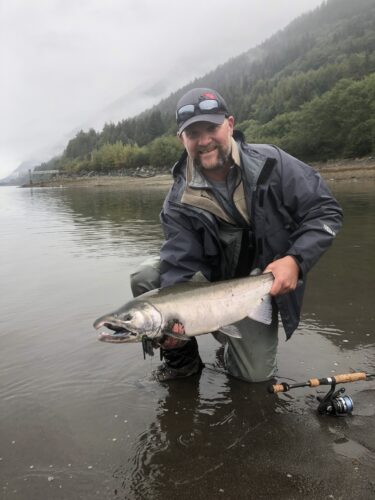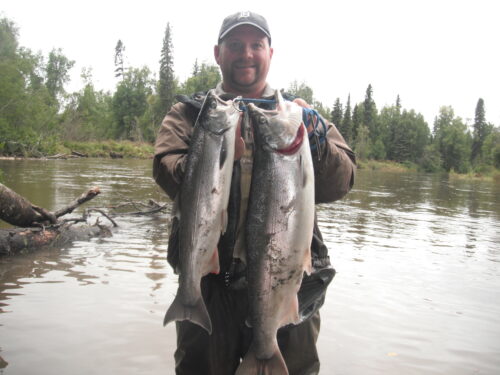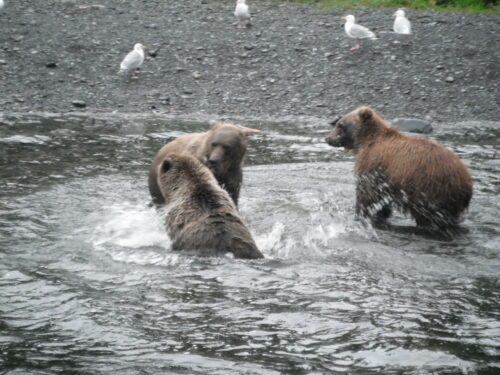
An Angler Tries To Solve The Coho Puzzle
The following appears in the September issue of Alaska Sporting Journal:

BY BRIAN M. KELLY
The tidal flats have a distinct scent at low tide, one that I long for when I am missing my happy place in Alaska. On this lovely misty early fall morning, each deep breath of the unique aroma of the salty sea air of the North Pacific was quite intoxicating.
The pace of my steps through the exposed patches of kelp and mussel beds was a little more accelerated than normal, as this would turn out to be the morning that dreams are made of. There was a heightened sense of anticipation from the minute my alarm woke me from a deep slumber: The weather change we were longing for had finally arrived and it had brought the mother lode of coho swimming just off our rod tip.
It had already been a successful trip, with limits coming for the entire group by 9 each morning. But the relentless sun-drenched skies kept the fish that were around us from really coming unglued. That all changed with a much-needed low-pressure system, which rolled in from the Gulf of Alaska. It brought low clouds, light rain and enough breeze to provide a surface disturbance that flipped the switch in the brains of the coho into full-on attack mode.

AS WE DROVE THE road along the Gastineau Channel, it was difficult to keep the wheel straight. It was an unending parade of fresh coho jumping as far as the eye could see. It was a bit of a mad scramble to get the gear on and hike out the peninsula, where the fish had been congregating all week.
The first cast and two twitches of my jig elicited a violent strike from a large buck that had bad intentions. Per usual, he rolled up the line and broke me off on the sharp edge of the gill plates. Hmm. Not the way I wanted to start this day, but it turned out to be the only tackle disruption of the morning.
When the bite really fires up, one tends to lose all track of time or desire for nourishment or hydration; it’s all about landing this fish, releasing it unharmed and launching another cast into what seems like an unending school of eager, hungry coho.
The highlight of this memorable morning was a window when the wind laid down and the angle of the light was perfect to allow a glimpse into the water for a few moments and appreciate what was happening. To actually see a line of blue-backed coho, fresh in from the Gulf of Alaska, strung out as far as the light would allow was truly a sight to behold.
Instead of casting through this immense school, I stood there in complete awe and just took in the moment. The salmon swam by at a steady, purposeful pace, as the seals and sea lions must’ve had their fill from previous days and let these fish be. The only disturbance came from a large hook-nosed male, which would swim up through the school just to let the rest of his compatriots know he was planning to be top dog when the spawning ritual arrived.
The urge to hook another fish got the best of me, so I gently flipped my jig out so I could watch the reaction of fish on the retrieve. Coho are the most inquisitive of the Oncorhynchus family, a trait that is heightened when they are schooled up. A pack of three or four fish would break away from the school and race to see which could eat my jig first. Usually, a smaller fish would make a burst at the lure, but would get muscled out by larger kin, typically a male. And they never missed; not on this day.
The next morning brought the same weather but a completely different attitude. One can never expect coho to be lit up every day, even in Alaska when you’ve timed the run dead on. The fish were still there and still coming by us in droves, but we were foul-hooking them in the side rather than the jig being down their mouth, like the day before. Then it dawned on us. These fish still had that open ocean instinct and were slashing at our jigs, just like they would slash at schools of herring in the high seas.
After a few lure changes, the fish got back into chomp-down mode. The thump of an all-black skirted spinner – no flash, no bright colors – did the trick on this particular morning. Which brings me to my point about chasing coho in the salt: Bring a wide assortment of lures or flies along on each and every outing, as these fish can change their mood with every tide swing and weather change.

I LEARNED THAT LONG ago, on my first salmon fishing trip to Alaska. The flight to Anchorage from Chicago O’Hare had felt like an eternity. My fishing partner was already on the ground ahead of my arrival, scouting out the coho streams
of the Mat-Su Valley. Technically, I was going “unguided,” but I’d been afforded the opportunity to be shown around by my friend, who had logged the miles and learned the hard lessons from previous trips on his own.
Water conditions were less than ideal, as a massive low-pressure system had rolled into the valley and was dumping steady rain day after day for several weeks. Fortunately, these watersheds can take some rain; after all, it is Alaska and rain is as common as sun is to the Florida Keys. While the water was stained and running higher than normal for this time of year, it was not muddy and there was certainly enough visibility for these coho migrating out of Cook Inlet to see our presentations.
As we hiked down the narrow trail to the river, my senses were heightened; this was bear country. Even though my fishing partner carried a nickel-plated bear deterrent – a revolver – and I was armed with my mighty bottle of store-bought pepper spray, the sense of pending grizzly doom was front and center. Of course, we never had an issue with bears; the underbrush and never-ending series of deadfalls along what will be kindly described as the “trail” that we followed upriver was another story. Eventually, the dense patch of spruces opened up to reveal a textbook bend hole with a convenient gravel bar to wade onto. My second cast across the run, which my mentor affectionately deemed the “Meat Hole,” resulted in a smashing strike from a fresh coho. Life brings us many “firsts” along the way, and this first had me tingling from head to toe. It was an absolute specimen of an Alaskan coho – dime-bright, with sea lice and the never-say-die spirit that makes coho so easy to love.
I slept like the dead that night, having just flown across the country and now being filled with the sensory overload that comes with an Alaskan adventure and the satisfaction of fresh filets in the freezer. It all sent me into one of those slumbers where your eyes shut and then the alarm goes off, with nothing but a peaceful calm in between. Well, maybe not for my fishing partner, as I apparently snored like the proverbial freight train that night. It happens.

On the drive down to the river the next morning, we came around a bend and startled a fox that was curled up and sleeping comfortably in the middle of the road. We slowed down, as the fox seemed a bit irritated to be awoken by our presence in the predawn darkness of this mid-August morning. (I put the emphasis on predawn, as coho don’t use banker’s hours.)
With headlamps on and starting our hike through the Alaskan bush, my pal abruptly stopped ahead of me, stuck his nose into the wind and said, “I think I smell a bear; you better lead the way.” As I took a step, he burst out in laughter because I’d fallen for his joke. If you can’t mess with those you fish with, who can you mess with?
When we arrived at the Meat Hole, which turned out to be the first-light honey hole on this particular trip, the air was dead calm, the woods eerily silent. Just as the skies began to light up in the east, we were startled by a loud crash coming down the hillside behind us.
We began yelling “Hey bear!” with the worry that we had somehow pissed off a grizzly and he was coming to get us out of his neighborhood. But that wasn’t the case. Instead, a cow moose was busting the brush with the intention of crossing the river.
As the adrenaline from the tense situation wore off, we saw her calf wander out from the brush on the opposite bank to greet mama as she swam across the river with ease. It’s moments like these that make Alaska so special.

CHASING UPSTREAM-MIGRATING COHO is like opening a puzzle box and spilling the pieces onto the table. Where do you start? How will this all come together?
Start with the “where” when it comes to the river. Coho will settle in the lower sections as they ride in with the high tides. If the rivers are low, the fish will hang down low and wait for the next rain event to move upstream. This situation can lead to an epic bite, as the fish will be concentrated. But you had better show up early, as the fish will get stale in a hurry once the sun gets on the water.
The “where” can also be way upriver, if a persistent low-pressure system brings high river conditions. Coho get the well-deserved nickname of “silver bullets,” as they will fly up many miles of river in short order, only stopping to catch their breath in the cold outflow of a creek or slough, all while maintaining their ocean-bright hue.
As for the “what” portion of the puzzle, that is the beauty of the coho. They will hit nearly any presentation you throw at them; just not at once. Which means, you pack it all and let them tell you what they want. On that day, at that moment, it works, but not tomorrow or the next day or even the next year. Which is why I love coho so damn much. It’s the puzzle that you never fully complete, but in the back of your mind you will. Someday. ASJ



